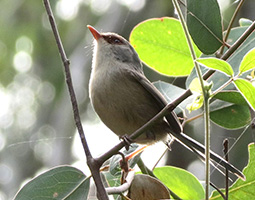Malurus lamberti
Description

The Variegated Fairy-wren, found in almost every part of Australia, is a small (15cm) cooperative breeding species, with small groups of birds maintaining and defending small territories year-round. In a species that exhibits sexual dimorphism (i.e. visual physical differences between the sexes), the brightly-coloured breeding male exhibits brilliant iridescent blue and chestnut, while non-breeding males, females and juveniles have predominantly grey-brown plumage.
They are found in forest, woodland and shrub land where they shelter in the scrubby vegetation. Birds maintain contact with each other by tsst or seeee calls, while a short, sharp tsit serves as an alarm call.
Breeding occurs from spring through to late summer; the nest is generally situated in thick vegetation and less than 1 metre above the ground. It is a round or domed structure made of loosely woven grasses and spider webs, with an entrance in one side, constructed by the breeding female. A clutch consists of three or four matte white eggs with reddish-brown splotches and spots. The female incubates the eggs for 14 to 16 days, after which newly hatched nestlings are fed by all group members for 10–12 days, by which time they are fledged. Parents and helper birds will feed them for around one month. Young birds often remain in the family group as helpers for a year or more before moving to another group.
Adaptations
- When breeding males change plumage to iridescent blue, while it is more likely to attract a female, they are also more likely to catch the eye of predators. Therefore, males spend more time scanning for predators and respond quicker to perceived threats while displaying their breeding plumage.
Feeding relationships
- What I eat: insects, small seeds
- What eats me: Other birds (e.g. Magpies, Butcher Birds, Kookaburras, Crows, Currawongs), foxes, feral cats, rats
Interesting facts
Like other fairy-wrens, male variegated fairy-wrens have been observed carrying brightly-coloured petals to display to females as part of a courtship ritual. In this species, the petals that have been recorded have been yellow.
Acknowledgements: Australian Museum, Wikipedia, Birds in Backyards